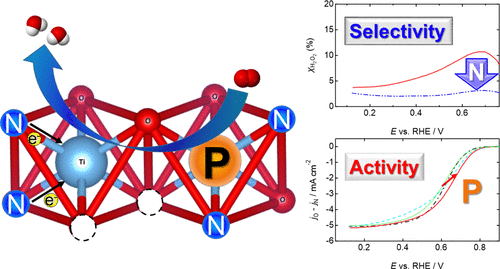当前位置:
X-MOL 学术
›
ACS Appl. Energy Mater.
›
论文详情
Our official English website, www.x-mol.net, welcomes your feedback! (Note: you will need to create a separate account there.)
Efficient Phosphorus Doping into the Surface Oxide Layers on TiN to Enhance Oxygen Reduction Reaction Activity in Acidic Media
ACS Applied Energy Materials ( IF 6.4 ) Pub Date : 2020-09-22 , DOI: 10.1021/acsaem.0c01576 Mitsuharu Chisaka 1 , Rong Xiang 2 , Shigeo Maruyama 2 , Hirofumi Daiguji 2
ACS Applied Energy Materials ( IF 6.4 ) Pub Date : 2020-09-22 , DOI: 10.1021/acsaem.0c01576 Mitsuharu Chisaka 1 , Rong Xiang 2 , Shigeo Maruyama 2 , Hirofumi Daiguji 2
Affiliation

|
Oxide catalysts have been developed in polymer electrolyte fuel cell cathodes to replace platinum-group-metal catalysts while retaining moderate oxygen reduction reaction (ORR) activity. Recently, carbon support-free titanium oxide (TiO2) catalysts formed on the outer surface of titanium nitride (TiN) have been shown to significantly increase ORR activity. In this study, ORR activity was further enhanced by increasing the surface phosphorus content on the disordered TiO2 layer by using hypophosphorous acid as a phosphorus source. Both the half-wave potential and limiting current density in acidic media were maximized to 0.66 V and 5.18 mA cm–2, respectively. Besides, the durability against high potential cycles between 1.0 and 1.5 V versus the reversible hydrogen electrode, which is critical to be used in vehicles, was enhanced. The decrease in half-wave potential during the 5000 cycles was suppressed to 0.08 V, which is 0.03 V lower than that in a previous study in which phosphoric acid was used. Furthermore, nitrogen doping on the catalyst under an NH3 flow improved the 4-electron ORR selectivity and reduced the hydrogen peroxide yield to less than half of the value with undoped catalysts. Although some phosphorus and nitrogen atoms were removed from the catalyst under high potential cycles, the surface oxides protected inner TiN for 5000 cycles. Codoping the TiO2 surface with large amounts of both phosphorus and nitrogen atoms is necessary to use this catalyst without relying on a high-cost system in which the potential is kept below 1.0 V.
中文翻译:

高效磷掺杂到TiN表面氧化物层中以增强酸性介质中的氧还原反应活性
在聚合物电解质燃料电池阴极中已经开发出氧化物催化剂来代替铂族金属催化剂,同时保持适度的氧还原反应(ORR)活性。近来,已显示出形成在氮化钛(TiN)的外表面上的无碳载体的二氧化钛(TiO 2)催化剂可显着提高ORR活性。在这项研究中,通过使用次磷酸作为磷源,通过增加无序TiO 2层的表面磷含量,可以进一步提高ORR活性。酸性介质中的半波电势和极限电流密度均最大化至0.66 V和5.18 mA cm –2, 分别。此外,相对于可逆氢电极(在车辆中至关重要),其在1.0至1.5 V之间的高电势循环下的耐久性得到增强。在5000个循环中,半波电势的下降被抑制到0.08 V,这比以前使用磷酸的研究低0.03V。此外,在NH 3流下将氮掺杂到催化剂上提高了4-电子ORR的选择性,并使过氧化氢的产率降低到未掺杂催化剂的一半。尽管在高电势循环下从催化剂中除去了一些磷和氮原子,但表面氧化物保护了内部TiN 5000次循环。共掺杂TiO 2 要使用这种催化剂,而不必依赖电势保持在1.0 V以下的高成本系统,必须同时使用具有大量磷和氮原子的表面。
更新日期:2020-10-26
中文翻译:

高效磷掺杂到TiN表面氧化物层中以增强酸性介质中的氧还原反应活性
在聚合物电解质燃料电池阴极中已经开发出氧化物催化剂来代替铂族金属催化剂,同时保持适度的氧还原反应(ORR)活性。近来,已显示出形成在氮化钛(TiN)的外表面上的无碳载体的二氧化钛(TiO 2)催化剂可显着提高ORR活性。在这项研究中,通过使用次磷酸作为磷源,通过增加无序TiO 2层的表面磷含量,可以进一步提高ORR活性。酸性介质中的半波电势和极限电流密度均最大化至0.66 V和5.18 mA cm –2, 分别。此外,相对于可逆氢电极(在车辆中至关重要),其在1.0至1.5 V之间的高电势循环下的耐久性得到增强。在5000个循环中,半波电势的下降被抑制到0.08 V,这比以前使用磷酸的研究低0.03V。此外,在NH 3流下将氮掺杂到催化剂上提高了4-电子ORR的选择性,并使过氧化氢的产率降低到未掺杂催化剂的一半。尽管在高电势循环下从催化剂中除去了一些磷和氮原子,但表面氧化物保护了内部TiN 5000次循环。共掺杂TiO 2 要使用这种催化剂,而不必依赖电势保持在1.0 V以下的高成本系统,必须同时使用具有大量磷和氮原子的表面。



























 京公网安备 11010802027423号
京公网安备 11010802027423号